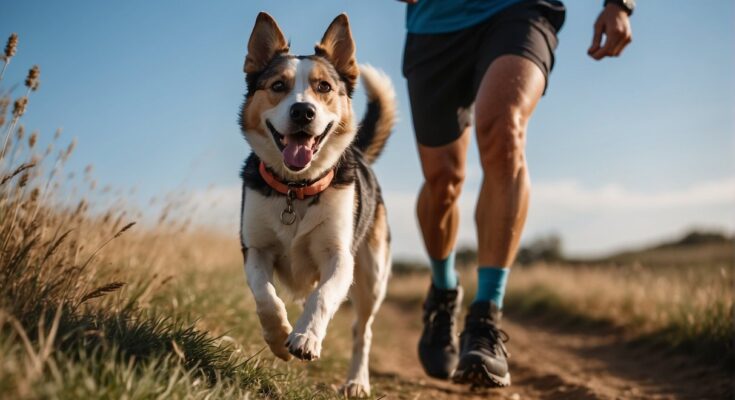Runners often seek companionship and motivation on their jogs, and dogs can be the perfect partners to keep them consistent and entertained. The activity is not only beneficial for human health, but it also provides dogs with the necessary exercise for a well-rounded lifestyle. Not every dog breed is suited for endurance running, so it’s essential to choose a breed that matches the runner’s pace and the distance they intend to cover.

Training is crucial when preparing a dog to be a running partner. Establishing obedience and understanding cues that are essential for safety in different environments are foundational before taking on the trails or pavement. Moreover, consideration for the dog’s health is paramount; it’s essential to ensure they are fit for running, and checking in routinely with a vet can help prevent injuries related to intense physical activity.
Key Takeaways
- Choosing a dog breed that matches running style is essential for a good partnership.
- Proper training ensures safety and enjoyment for running with dogs in various settings.
- Regular health check-ups are crucial to maintain a dog’s fitness for running activities.
Best Dog Breeds for Runners
Choosing the right dog breed is critical for runners seeking a four-legged running partner that matches their pace and endurance. Strength, agility, and energy level are pivotal traits that determine the suitability of the dog breed for running activities.
Weimaraners
The Weimaraner is a top choice for runners due to its remarkable stamina and muscular build. Originally bred as a hunting dog, Weimaraners possess an energy level that thrives on exercise and can easily keep up with runners on long distances.
Vizslas
Vizslas are known for their agility and love for exercise, making them excellent running companions. As high-energy dogs, Vizslas have the endurance to accompany runners for extended periods, their lean bodies allowing for quick and efficient movement.
Dalmatians
With a heritage as carriage dogs, Dalmatians have great stamina and can maintain a steady, long-distance pace. These spotted companions are suited for runners as their high-energy level and robust health make them ideal for lengthy runs.
German Shorthaired Pointers
Notable for their athleticism and intelligence, German Shorthaired Pointers are well-suited to runners who enjoy varied workouts. These dogs are adaptive and can handle different running terrains, thanks to their combination of energy, strength, and keen senses.
Rhodesian Ridgebacks
Rhodesian Ridgebacks were bred to hunt lions and have a distinct muscle tone and strength, which translate into impressive endurance. They are a strong match for runners, especially those living in hotter climates, as this breed can handle high temperatures well.
Dog Training for Runners

Training a dog to be a runner’s companion involves a structured approach to build endurance, improve strength and agility, and master obedience for a successful partnership. This ensures the dog will be physically and mentally prepared to match the runner’s pace and distance.
Building Endurance
To build a dog’s endurance, start by incorporating short runs into their exercise routine and gradually increase the distance. A structured plan may look like:
- Week 1-2: Walk and light jog for 1 mile, 3 times a week
- Week 3-4: Increase to 2 miles of jogging, 3 times a week
- Week 5-6: Introduce steady running for 3 miles
Monitor the dog’s energy level and stamina, ensuring they are comfortable and not overexerting themselves.
Strength and Agility Training
Strength and agility training enhance a dog’s athletic abilities, making them more agile and able to navigate various terrains. Activities might include:
- Obstacle courses: Create a homemade course or visit a dog park equipped with agility equipment.
- Hill runs: Incorporate short bursts up and down hills to build leg muscle strength.
Improving the dog’s physical condition will also increase their running efficiency and prevent injuries.
Obedience and Command Work
Obedience training is crucial for a safe and enjoyable running experience. Command work should focus on:
- Heel: The dog should learn to run alongside the runner without pulling.
- Recall: Ensuring the dog returns when called, regardless of distractions.
- Stop/Stay: Vital for moments when the runner needs to pause or control the situation.
A well-trained dog will respond quickly to commands, strengthening the bond between the dog and the runner, and creating a reliable running partner. Obedience and intelligence training provide mental stimulation, which is as important as physical exercise.
Regular training across these areas will result in a disciplined and content companion, ready to tackle long-distances and varied running adventures with their human partner.
Health Considerations for Running Dogs

Running with dogs provides excellent exercise for both the pet and the owner, yet it demands careful attention to the animal’s health. The breed, size, age, and individual health needs of a dog play a pivotal role in how they should be managed when running.
Preventing Hip Dysplasia
Hip dysplasia is a common concern in many breeds, particularly those that are large and heavy. To prevent this condition, ensure a running regimen that includes:
- Warm-up and cool-down exercises to gradually increase heart rate.
- Avoidance of hard surfaces to reduce impact on the joints.
- Regular, moderate, rather than intense, high-impact activities.
Dealing with Weather Conditions
Monitoring weather conditions is critical for the safety and comfort of a running dog. Guidelines include:
- In hot weather, shorter runs during cooler parts of the day and access to plenty of water are essential.
- Cold weather requires paying attention to the dog’s tolerance, potentially using protective gear against frostbite.
- Dogs with short coats may need additional warmth, while those with thick fur can overheat quickly.
Senior Dogs and Puppies
Young puppies and senior dogs have different energy levels and health considerations, such as:
- Puppies: Introduce exercise gradually to prevent damage to developing joints and be mindful of their high energy levels.
- Senior dogs: Opt for lower intensity activities and shorter distances; assess their exercise tolerance regularly.
Veterinarian Care and Nutrition
Optimal veterinarian care and nutrition are fundamental to a running dog’s performance and well-being. Key aspects include:
- Regular check-ups to monitor health status and catch potential issues early.
- Balanced diets tailored to the dog’s age, weight, and exercise level, ensuring they have the right energy for running without becoming overweight.
By focusing on these health considerations, runners can help ensure their four-legged companions stay happy and healthy on the run.
Running with Your Dog in Different Environments
Selecting the right environment for running with your dog can enhance the experience for both the runner and their canine partner. Consider the dog’s size, endurance, and the local weather before setting out.
Trail Runs
When running on trails, the terrain can be unpredictable, ranging from soft soil to rocky paths. Dogs often enjoy the variety and exercise, but they should have a good recall command due to potential wildlife. Smaller dogs may find rough terrain challenging, whereas larger dogs with more endurance could thrive. Always check the dog’s paws post-run for any injuries.
Urban Jogging
Jogging on pavement requires attention to the surface temperature, as hot asphalt can burn a dog’s pads, while cold pavement can lead to discomfort or injury. Urban settings can offer stimulating environments, but they may also include hazards such as heavy traffic. It’s crucial to keep dogs on a leash and ensure that they are comfortable with the sounds and activity level.
Running with Dogs in Heat or Cold
Weather greatly affects the safety and comfort of running with dogs. In heat, dogs are susceptible to overheating; therefore, run during cooler parts of the day, and carry water for your dog to prevent heatstroke. In cold weather, smaller dogs or those with short fur might need a coat for insulation, and beware of icy conditions that can lead to slips and falls. Adjust the intensity and length of the run according to the temperature to maintain your dog’s energy levels.
Remember to monitor your dog’s behavior for signs of fatigue or discomfort in any running environment, and adapt accordingly.
Choosing the Right Running Partner
Selecting a canine companion for running requires matching energy levels and physical attributes to ensure both runner and dog can share enjoyable, healthy exercise.
Energy and Exercise Needs
A runner must assess a dog’s energy level and exercise requirements before making a choice. High-energy dogs are well-suited for long-distance runners due to their natural stamina and desire for extended activity. Breeds such as Border Collies, Vizslas, and Weimaraners typically possess the vigor necessary for continuous running. However, a dog that requires more mental stimulation may need varied activities beyond the routine run.
Size and Build Considerations
The size and build of a dog can greatly affect its running capability. A dog’s weight should be proportionate to its size to prevent joint stress, while long legs are conducive to a smooth and efficient running gait. Large breeds with a lean build, like the Doberman Pinscher, are excellent for sprints and runs, whereas dogs with short legs may struggle with pace and endurance.
Temperament and Compatibility
Temperament plays a pivotal role in the bond between runner and running partner. A dog must be even-tempered, responsive to commands, and sociable with other runners and animals encountered on the trail. Canines with a cooperative nature, such as Golden Retrievers or Labrador Retrievers, are often great matches for the consistent companionship and teamwork that running with a human partner necessitates.




